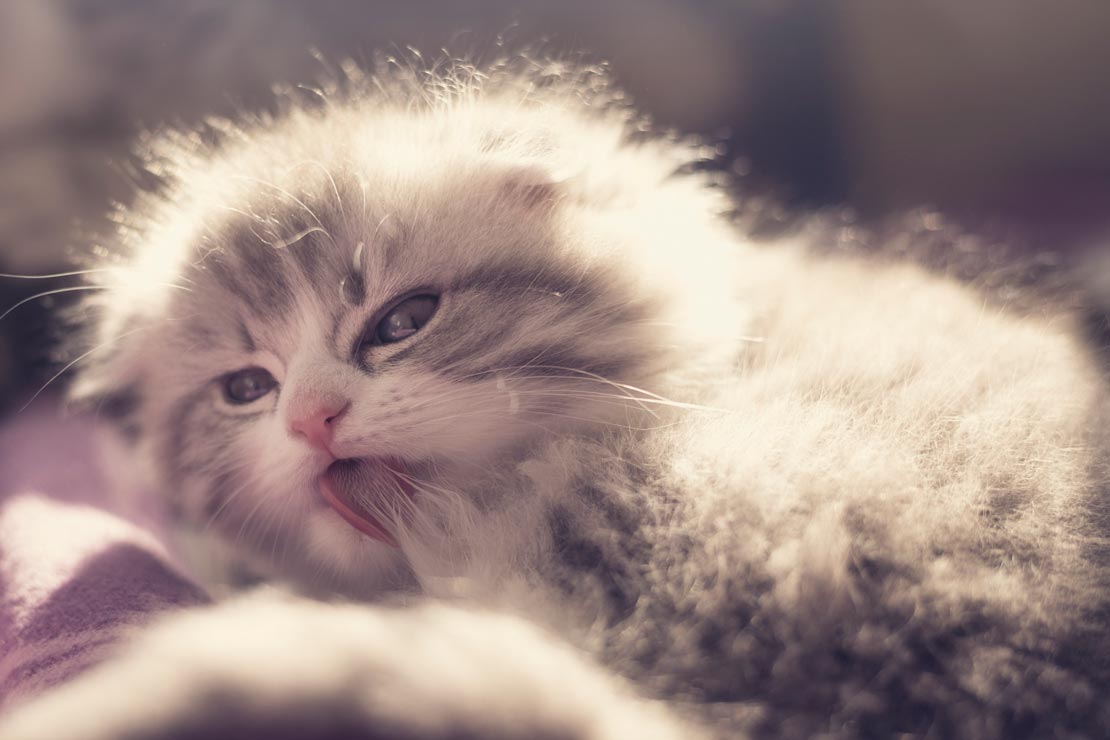Why Does My Cat Pull His Hair Out?

Grooming is a top priority for most cats. They spend a lot of time using their tongues and teeth to clean themselves. This is normal cat behavior, and it's good for their skin and hair coat.
However, some cats over-groom, actually pulling out fur that wasn't loose to begin with. These cats often end up leaving bald spots on themselves and even developing skin infections from too much licking and biting.
Sometimes, you might not notice your cat over-grooming. Some cats engage in it while out of sight of their humans. The only indication your cat is doing so might be that you find piles of hair lying around, he develops bald spots surrounded by hairs that are broken off, or there's an increase in his hairball vomiting.
There are a few reasons cats engage in pulling their own fur out, and it might take some sleuthing and medical testing to determine why an individual is engaging in it.
Something Is Itchy to the Cat
The majority of the time, a cat that is over-grooming is doing so because he feels itchy. The only ways a cat has to scratch an itch are with his back claws and his teeth.
Medical conditions that can cause a cat to feel itchy and subsequently over-groom include:
- Fleas, especially a flea allergy. Even indoor cats can get fleas, so don't assume this isn't the problem if your cat begins licking and chewing at himself. And, if a cat is allergic to flea saliva, it only takes one bite to create a big skin reaction. It can be challenging to find fleas or flea dirt on cats because they are such fastidious groomers.
- Mites. Several types of mites can cause problems in cats, including ear mites, demodex, and scabies. These mites aren't visible except microscopically, so an ear cytology or skin scraping is needed to diagnose them.
- Lice. Cats don't get lice from people. They have their own type of species-specific lice, and they pick them up from other cats or the environment in which an infected cat was.
- Food allergy. An allergy to some component of a cat's food, usually the protein source, can cause severely itchy skin in some cats.
- Inhalant allergy. If your cat gets itchy at certain times of the year, inhalant allergies to molds, spores, or pollen might be the culprit.
- Contact allergy. Some cats are allergic to certain laundry detergents or other products used in the home with which they come into direct contact.
- Fungal infection like ringworm. Ringworm is especially prevalent in kittens, and it's quite contagious to other cats and humans, so catching it early and treating it aggressively is essential. Cats don't get the classic ring-shaped lesion on their skin when they have ringworm like humans often do, so it's important to have a veterinary exam to diagnose it.
- Bacterial infection. Itchy bacterial skin infections in cats are usually secondary to something else, like an allergy or a wound.
A veterinarian will do a thorough exam and take a detailed history of the problem from you if your cat is over-grooming. Then, he or she may do some tests such as a skin cytology, culture, or scraping to look for some of these issues.
Something Is Painful to the Cat
Cats often lick or even chew on areas of their body that are uncomfortable or painful. That could be a wound, an arthritic joint, the rear end if there is an anal sac infection, or the abdomen when there is a urinary tract problem. If your cat suddenly begins licking one specific spot on the body, have her checked out right away, especially if it coincides with any other signs of illness like limping, urinating outside the box, having a wound, sore, or swelling on the skin, or not wanting to eat.
An Over-Grooming Cat Might Have Psychogenic Alopecia
Cats may over-groom when they are stressed about something, and that's called psychogenic alopecia. In this case, the grooming helps them feel some comfort, like when a person chews their nails while nervous, so they begin to engage in it almost compulsively.
When cats have psychogenic alopecia, a specific event or situation can often be traced as the trigger. Some common ones include:
- A new baby in the home
- Remodeling of the house
- Other cats invading the yard of an indoor cat
- A new schedule for the primary caretaker
Many times, a cat suffering from psychogenic alopecia is also showing other signs of stress, like inappropriate urination or unwanted scratching behavior.
Behavioral causes of over-grooming are much less common in cats than medical ones. Some cats require anti-anxiety medications and behavioral modification therapy to resolve their stress-related over-grooming. A visit to your vet is required. Never give your cat medication without checking with your vet first.
You May Also Like These Articles:
My Cat Is Pacing All Night: What's Up?
Why Do Some Cats Bunny-Kick Things?
Why Does My Cat Sleep on My Head?
Why Do Some Cats Carry Food Out Of Their Bowls to Eat It?
Why Do Some Cats Dip Their Paws in the Water Bowl?
Panting in Cats: What Does It Mean?
Notice: Ask-a-Vet is an affiliated service for those who wish to speak with a veterinary professional about their pet's specific condition. Initially, a bot will ask questions to determine the general nature of your concern. Then, you will be transferred to a human. There is a charge for the service if you choose to connect to a veterinarian. Ask-a-Vet is not manned by the staff or owners of CatHealth.com, and the advice given should not delay or replace a visit to your veterinarian.






